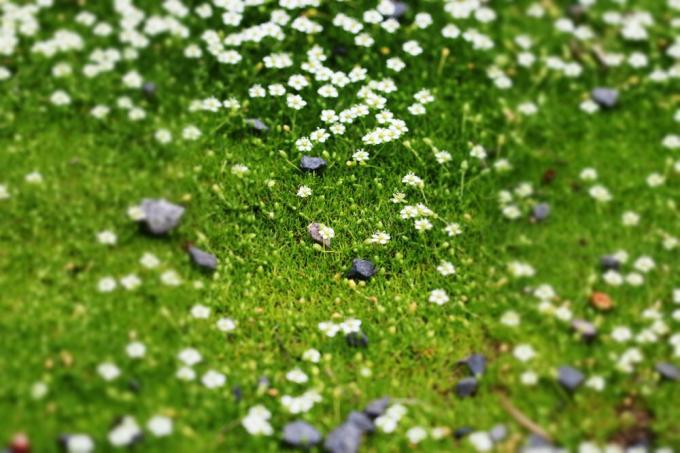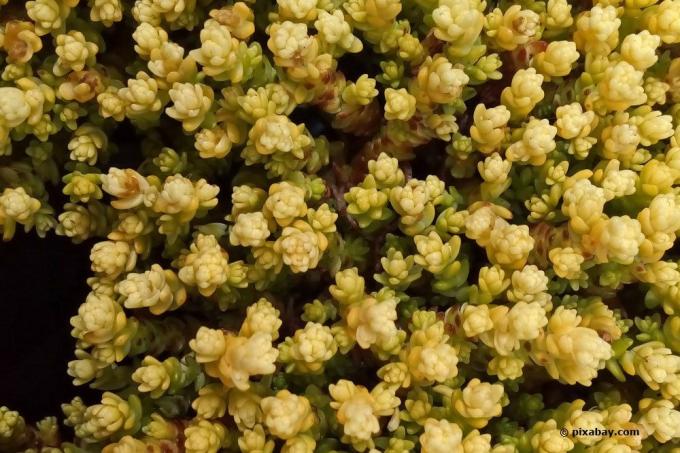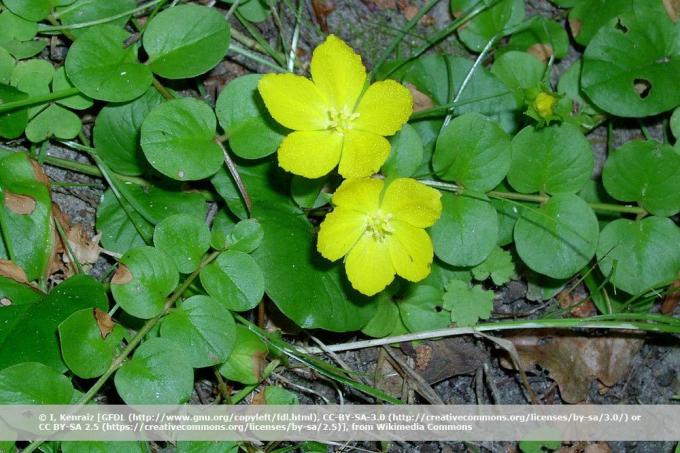
table of contents
- Ground cover as a substitute for lawns
- To be observed before planting
- Advantages and disadvantages of lawn replacement
- Choice of cushion plants
- Ground cover from F - M
- Ground cover with P
- Ground cover from R - S
- Ground cover from T - Z
A well-tended lawn is always the most expensive area in the garden. Because the care can be very intensive. It has to be mowed, scarified, fertilized and watered regularly. Everything takes up a lot of time. But there are also areas in the garden where race does not grow very well. A good alternative is a lawn substitute. Evergreen tread-resistant Ground cover, are particularly suitable for this. They are easy to care for and still grow in almost all locations.
Ground cover as a substitute for lawns
Various plants can be planted as substitutes for lawns for greening areas. However, these are mainly used as ornamental lawns. The ground cover are indeed stable. but not as resistant as normal lawn. The areas are accessible. However, if you run regularly, you can quickly get on the beaten track. Such a lawn replacement is particularly suitable for problem areas in the garden or for the easy-care greening of small areas.
Ground covers are plants that
- grow low
- cover the floor with a carpet
- are walkable, evergreen and mostly hardy.
Most plants have some degree of crush resistance. Evergreen does not always have to mean that the leaves always keep their green color even in winter, but that the leaves are preserved during the cold season.

tip: Different types of ground cover planted on one area set special accents.
To be observed before planting
Before planting the lawn substitute, the soil must be well prepared. Roots and weed are to be removed. the bottom should
- be loose and permeable
- no waterlogging occurs
- loosen loamy soils with sand
- If necessary, bring in ripe compost depending on the type of plant
10 to 15 plants per square meter are then placed in the loosened soil. Slow-growing varieties should be planted more densely to prevent weed growth.
tip: Many flowering ground covers attract bees and others insects at. These should never be entered barefoot as this can lead to painful stitches on the soles of the feet.
Advantages and disadvantages of lawn replacement
Of course, replacing the lawn with evergreen, hard-wearing ground cover brings some Benefits with himself. so can among other things
- the soil quality can be improved
- Ground covers have special ornamental value
- are easy to care for
- offer protection against weeds and drying out of the soil
- attract bees and butterflies
- are usually hardy and evergreen
In addition, the planting of lawn substitutes also brings some disadvantage:
- Attracting unwanted insects, for example Wasps
- higher maintenance effort in autumn, depending on the variety
- not all plants are really hard-wearing
A distinction is made between hard-wearing and walk-on ground covers. Sturdy plants can withstand frequent and firm footsteps by humans and animals such as Roman chamomile, thyme or that Star moss and Feather pads. In contrast, plants that can be walked on should be rarely and carefully entered, for example hazel root.
Choice of cushion plants
Which plant is used in each case always depends on various factors such as
- Use of the lawn substitute
- location (sun, shade, penumbra) and
- Size of the area
There are now different types of ground cover that are suitable as a substitute for a lawn, such as flowering or evergreen cushion shrubs. The selection is quite large and there is something for every taste.
Ground cover from F - M
Plumage (cotula)
This vigorous upholstery shrub is also known as the lye flower. The small yellow and inconspicuous flower heads appear from May to July. They give off a wonderful scent of honey. The foliage is very dense and feathery. It is similar to small mini ferns.
- Height 5 to 10 cm
- Forming runners, width up to 45 cm
- leaves green in summer, turning coppery to black in winter
- Not all varieties are hardy, pay attention when choosing
- sunny to partially shaded locations
- well drained, slightly moist soils
- no waterlogging
- loosen soil that is too rich in nutrients or firm with sand
- 15 to 20 plants per square meter
- water well after planting
- susceptible to cold frosts and winter sun
- Cover with brushwood in autumn, otherwise brown
- light fertilization in spring with compost or organic fertilizer
- heavy inspection, creation of walkways
- water when dry

tip: It is advisable to lay stepping stones if the surfaces are frequently walked on.
Stonecrop (Sedum acre)
The hot stonecrop enchants from June to August with its star-shaped yellow flowers. The pile-forming perennial is hard-wearing. The feeling of stepping barefoot is extremely pleasant.
- Height 5 to 15 cm
- particularly suitable for smaller areas
- creeping, robust and easy to care for
- hardy and evergreen
- withstands longer dry periods
- full sun location

Ground cover with P
Pennywort (Lysimachia nummularia)
This evergreen perennial is also known as mint or loosestrife. Bright yellow flowers appear from May to July. Cultivation and maintenance are relatively easy.
- Height 5 to 10 cm
- prefers partial shade
- but can also cope in the sun
- undemanding, hardy and evergreen
- grows on areas where nothing else thrives
- robust and hard-wearing
- but not necessarily suitable for daily play and romp
- Otherwise there will be bald spots
- then also restricted growth
- We recommend pruning once a year

Polemint (Mentha pulegium)
This herb blooms profusely from July to August / September. The flowers are pink to pale purple. The perennial is evergreen and just as hardy:
- Height up to 5 cm
- prefers partial shade
- step-resistant
- relatively soft, so it can be walked barefoot
- after walking, intense smell of mint

Purple dead nettle (Lamium purpureum)
This very hardy lip flower is robust and adaptable. The purple, white, pink or blue-green flowers appear from March to October and the leaves are green all year round.
- prefers shade or partial shade
- growing densely
- Height up to 45 cm
- Cutting back with a lawnmower
- Spring fertilization with compost or organic fertilizer
- attracts bees and butterflies
- ideal for stony, sandy, barren soils
- also grows where nothing else thrives

Ground cover from R - S
Roman chamomile (Chamaemelum nobile)
This evergreen, hard-wearing ground cover is also known as lawn chamomile. Between June and September the white flowers with a pleasant smell of chamomile appear with a yellow center. The perennial is hardy and
- becomes a maximum of 15 cm high
- Can be cut with the lawn mower raised
- but only upright branches should be cut
- dense growth
- evergreen to evergreen
- loves a sunny location
- Partial shade still tolerable
- prefers dry soils
- Enrich loamy soils with sand
- Planting time autumn and spring
- very surefooted
- the more is committed, the faster the growth

tip: The Roman chamomile is very prolific. It should therefore absolutely be escape-proof Lawn edges be set.
Star moss (Sagina subulata)
This cushion shrub is not a type of moss, as the name suggests, but a fattening herb from the carnation family. Its name was derived from the white star-shaped flowers, which appear in large numbers from June to August. The leaves are small, narrow and wedge-shaped. The evergreen, sturdy upholstery plant exudes a pleasant, intense scent. Due to its height, the star moss is an ideal substitute for lawn.
- forms dense cushions
- Height five centimeters
- tolerates temperatures down to -35 ° C
- Location partially to shady
- loves light, nutritious and moist soil
- no waterlogging
- Improve too light soils with ripe compost
- occasional fertilizers
- Plant 15 plants per square meter
- if the plant gets too tall, shorten it with scissors
- promotes branching
- Remove leaves in autumn
- Formation of moisture under leaves
- Plants then rot

tip: After a few weeks, the plants will then lift off the ground. Then simply press it back on. Frequent walking can help.
Ground cover from T - Z
Carpet verbena "Summer Pearls" (Phyla nodiflora)
This upholstered shrub originally comes from Japan. There is a sea of flowers in white-pink from May to October. The small round flowers give off a slightly sweet scent. Carpet verbena is the best alternative to classic lawns. Because it can score points with various advantages such as
- evergreen hardy ground cover
- in winter the leaves turn brown
- tolerates dryness and wetness
- Roots almost three feet deep in the ground
- thus supply of water during drought possible
- fast growth
- one square meter covered within a few months
- Gaps are closed quickly
- Height up to 5 cm
- easy-care
- no mowing
- no formation of walking paths
- prefers sunny locations
- high step resistance, tolerates occasional football games

Thyme (thymus)
The upholstery thyme is particularly suitable here. Depending on the variety, reddish, purple, white-lilac or delicate lilac flowers appear from April to August. They beguile with their aromatic scent. Thyme is both evergreen and hardy:
- fast growing
- forms dense cushions
- Planting in spring
- thick carpet formed within one growing season
- Distance between plants 15 to 20 cm
- Plant grows sideways
- Height from 2 to 10 cm
- loves a sunny location with poor, sandy soils
- Remove weeds regularly until they have spread
- attracts bees
- particularly hard-wearing, for example Thymus cherlerioides or Thymus praecox minor

tip: Sand thyme (Thymus Serphyllum) is particularly suitable for a fragrant lawn.
Cotoneaster dammeri
Small flowers appear from May to July in various colors from white to cream to red. After that, red fruits that resemble berries are formed in autumn.
- Height up to 15 cm
- roots itself
- loves a sunny location
- well-drained and moist soils preferred
- evergreen and hardy
- perfect for smaller areas
- step-resistant

tip: The berries of the cotoneaster are slightly poisonous. Therefore, caution is advised with small children and pets.
